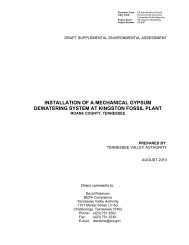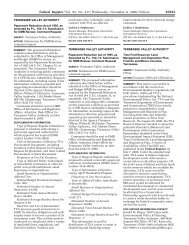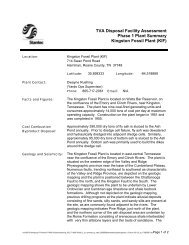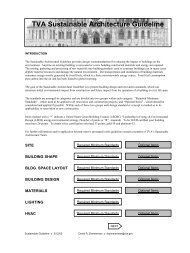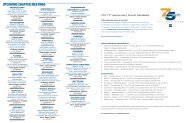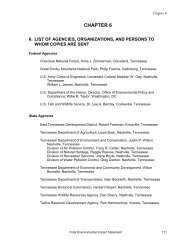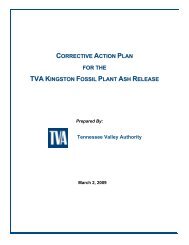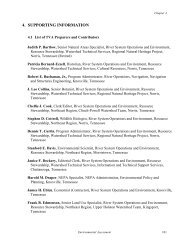Environmental Assessment - Tennessee Valley Authority
Environmental Assessment - Tennessee Valley Authority
Environmental Assessment - Tennessee Valley Authority
You also want an ePaper? Increase the reach of your titles
YUMPU automatically turns print PDFs into web optimized ePapers that Google loves.
A brief description of species potentially occurring near the project can be found below.<br />
Biology and habitat requirements are described in Etnier and Starnes (1993) and<br />
NatureServe (2011) for fish and in Parmalee and Bogan (1998) for mussels.<br />
Flame Chub: An inhabitant of springs and spring runs, the flame chub, usually occurs in<br />
areas of lush aquatic vegetation. It occurs in the <strong>Tennessee</strong> River drainage from the<br />
Knoxville area downstream through the Mud Creek system south of Savannah (Hardin<br />
County), <strong>Tennessee</strong>. The species also occurs in the upper Duck River and in the middle<br />
Cumberland drainage, primarily in the upper Caney Fork system. Habitat for flame chub is<br />
not expected to occur within impact areas of the proposed project in Watts Bar Reservoir;<br />
therefore, this species is not considered further in this EA.<br />
Snail Darter: This species occurs in deeper portions of rivers and reservoirs where current<br />
is present. The snail darter spawns from February to mid-May through August. Larvae drift<br />
downstream into deeper, lower-velocity areas. In late summer, the juveniles migrate<br />
upstream to shoal areas where they spawn. Snail darter larvae and juveniles may occur<br />
within the project impact area.<br />
Tangerine Darter: The tangerine darter inhabits clearer portions of large to moderate-sized<br />
headwater tributaries of the <strong>Tennessee</strong> River. It frequents deeper riffles and runs with<br />
boulders, large rubble, and bedrock most of the year but moves into deeper pools in winter.<br />
It is confined to the upper <strong>Tennessee</strong> River drainage and reaches maximum abundance in<br />
smaller tributaries such as the Emory, Little Emory, Little Pigeon, Tellico, and Hiwassee<br />
rivers. Habitat for tangerine darter is not expected to occur within impact areas of the<br />
proposed project in Watts Bar Reservoir; therefore, this species is not considered further in<br />
this assessment.<br />
Orangefoot Pimpleback: This species inhabits medium to large rivers in moderate current<br />
in sand, gravel, and/or cobble substrate often in deeper water. Historical records are<br />
known to occur within a 10-mile radius of the proposed project area. The USFWS issued a<br />
2007 Final Rule to reintroduce experimental populations in the lower French Broad and<br />
lower Holston rivers. As recognized in the 2011 BA and BO associated with this project,<br />
orangefoot pimpleback is believed to occur within the project impact area in very low<br />
numbers. However, the USFWS BO concluded that, given the extremely rare occurrence<br />
of orangefoot pimpleback and nature of potential indirect impacts from the proposed<br />
project, the level of impacts to this species would not rise to the level of “take.” Therefore,<br />
orangefoot pimpleback is not considered further in this EA.<br />
Pink Mucket: Typically, a big river species, the pink mucket occasionally becomes<br />
established in small to medium-sized tributaries of large rivers. It generally inhabits rocky to<br />
sand/gravel substrates with swift current, usually in less than 3 feet of water; however, it<br />
has been found living and reproducing in reservoir habitat containing adequate flow.<br />
Suitable habitat occurs near the project, and it is believed to inhabit the project impact area<br />
in low densities (CCR <strong>Environmental</strong> 2011; USFWS 2011).<br />
<strong>Tennessee</strong> Clubshell: This species occurs in the <strong>Tennessee</strong> and Cumberland rivers’<br />
drainages. The <strong>Tennessee</strong> clubshell prefers substrate of coarse gravel and sand in small,<br />
shallow creeks and rivers with good current. Spawning likely takes place in spring, and<br />
larvae are expelled during summer, with several fish species shown to serve as<br />
reproductive hosts. The project impact area does not likely support appropriate habitat for<br />
<strong>Tennessee</strong> clubshell; therefore, this species is not evaluated further in this assessment.<br />
6





